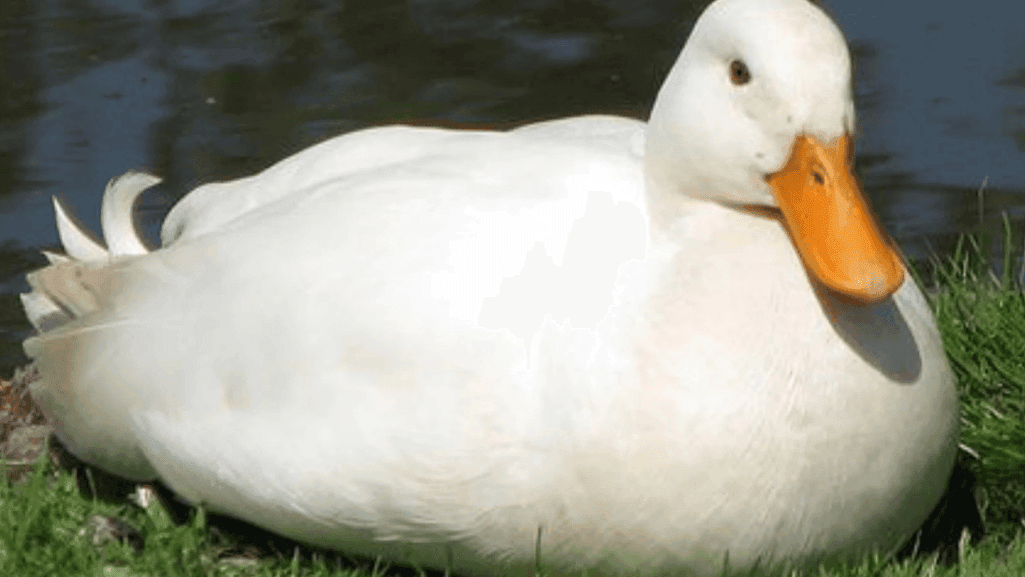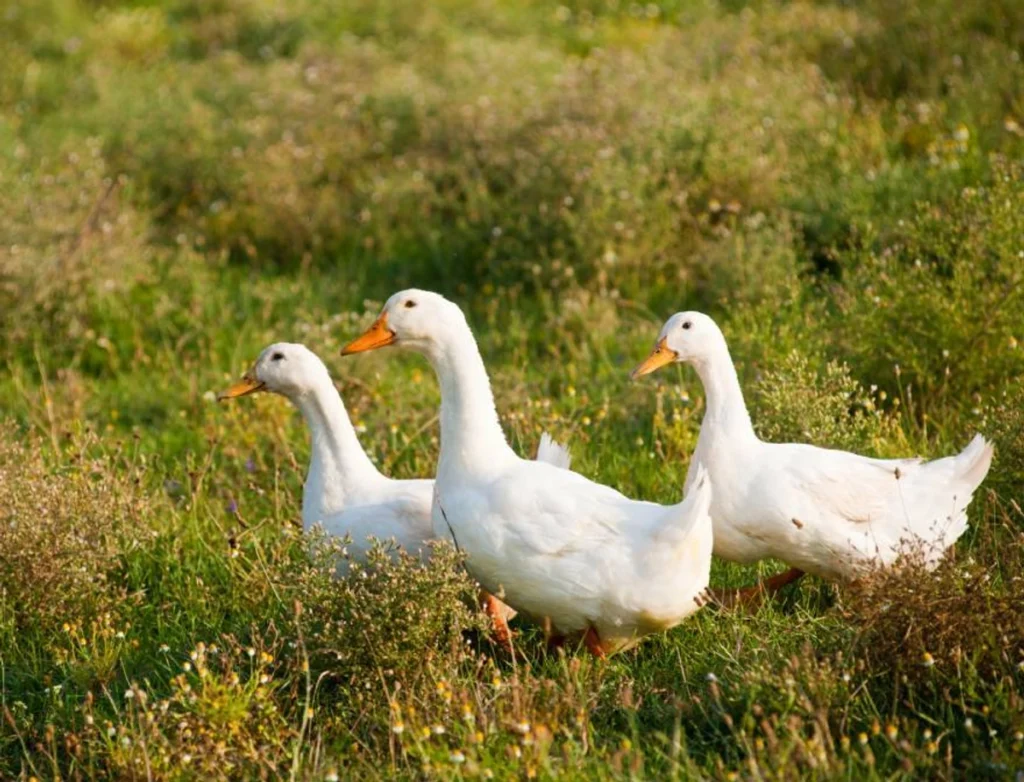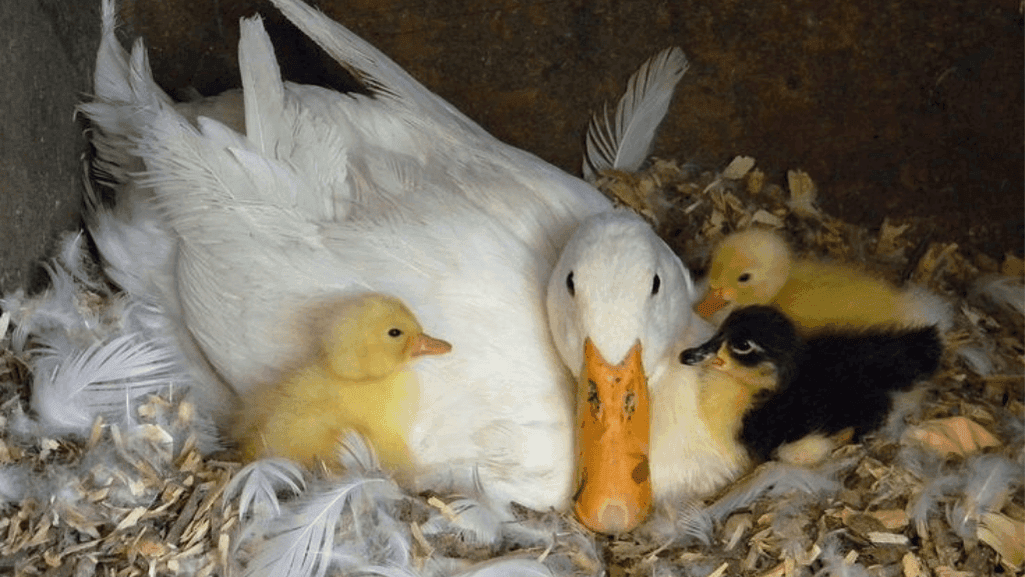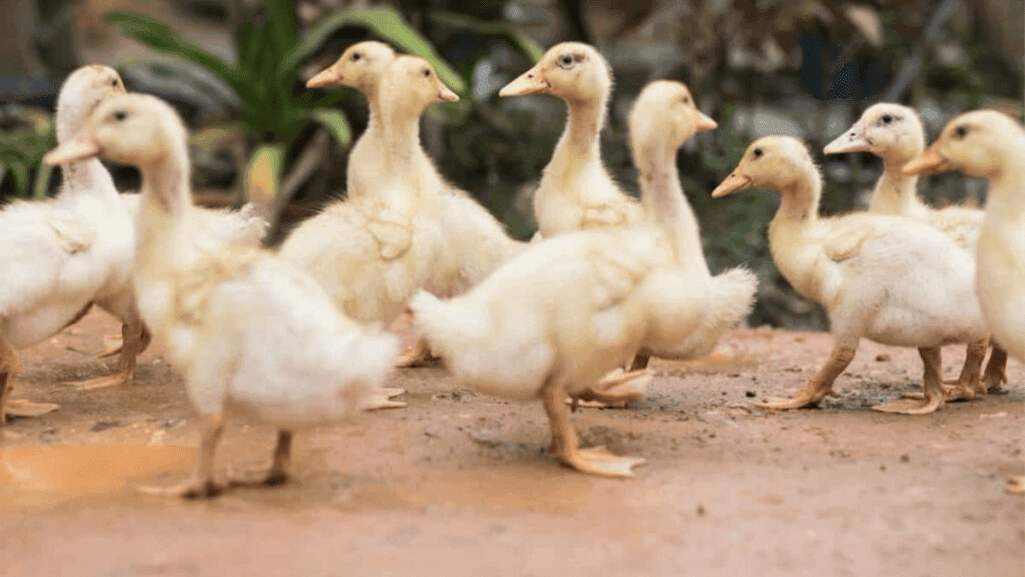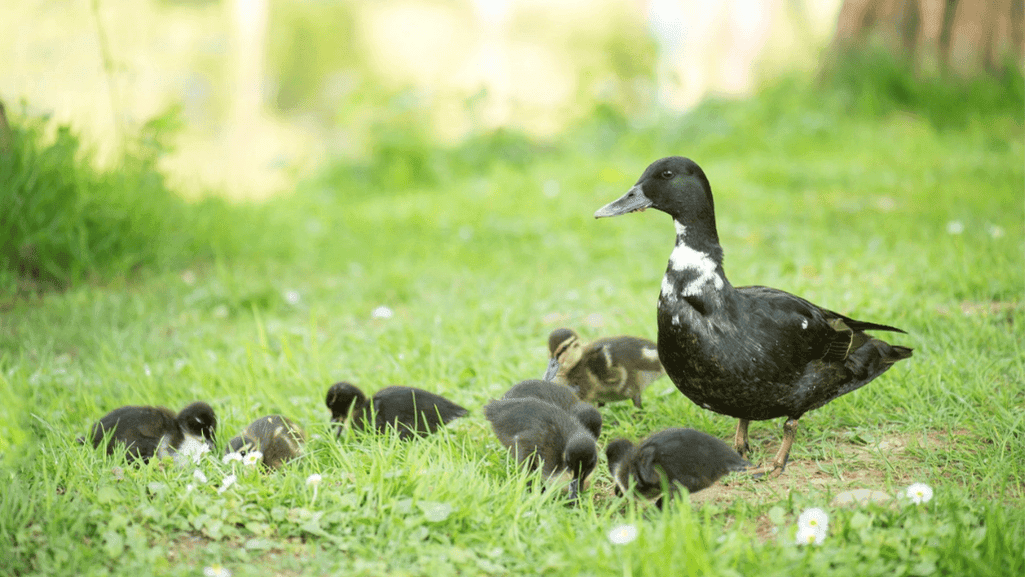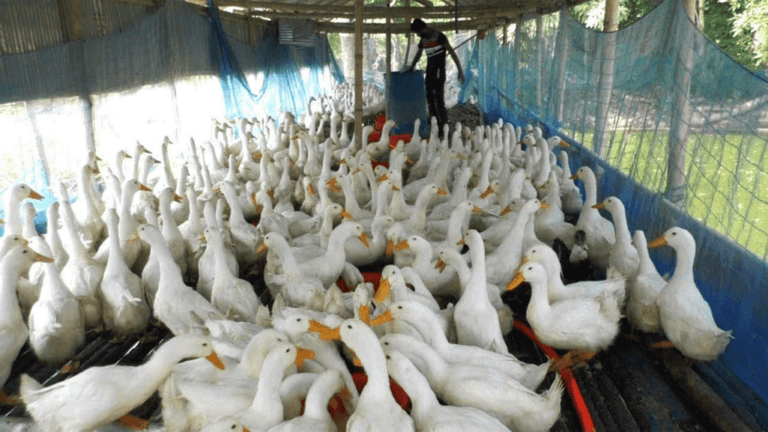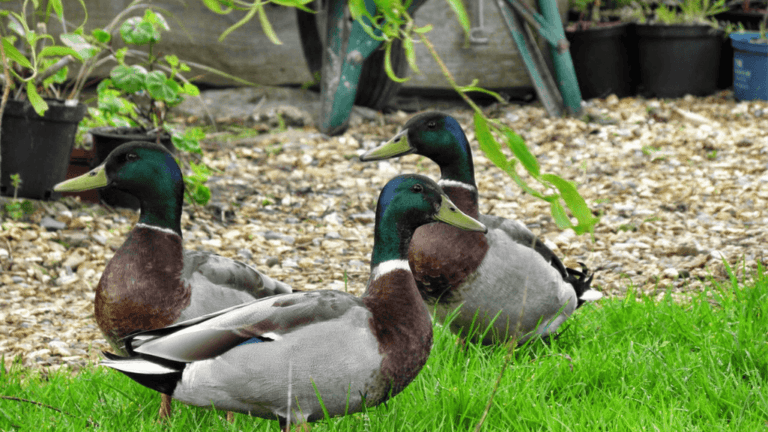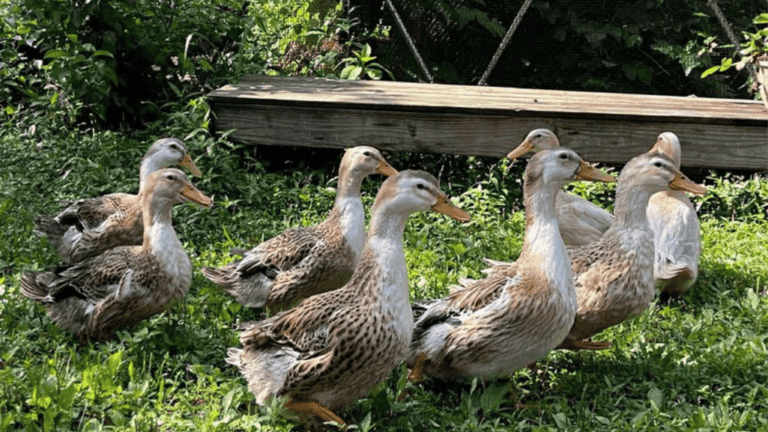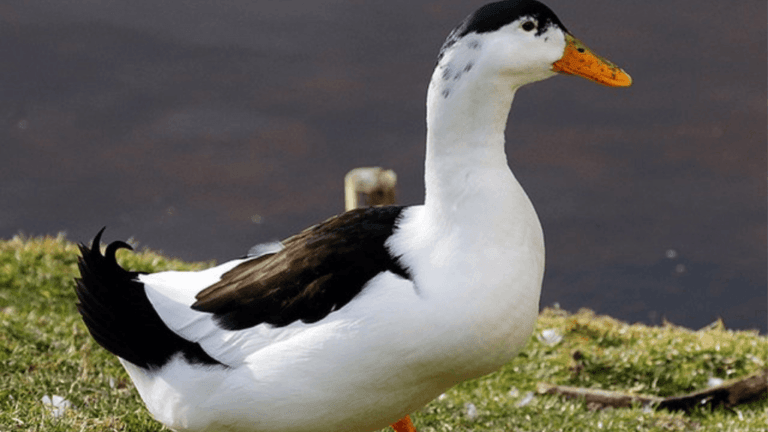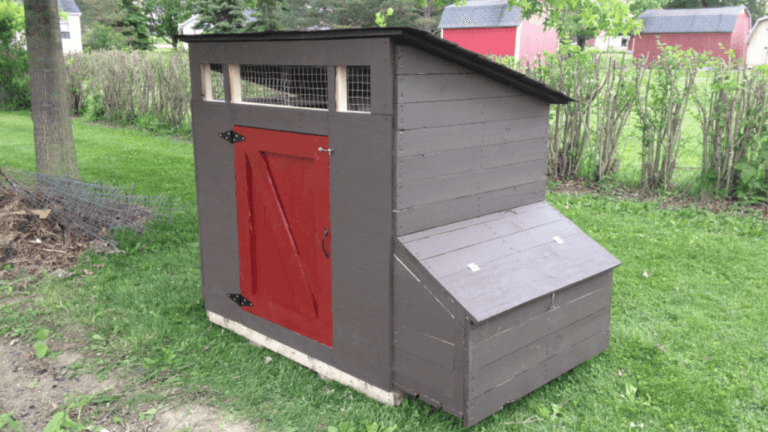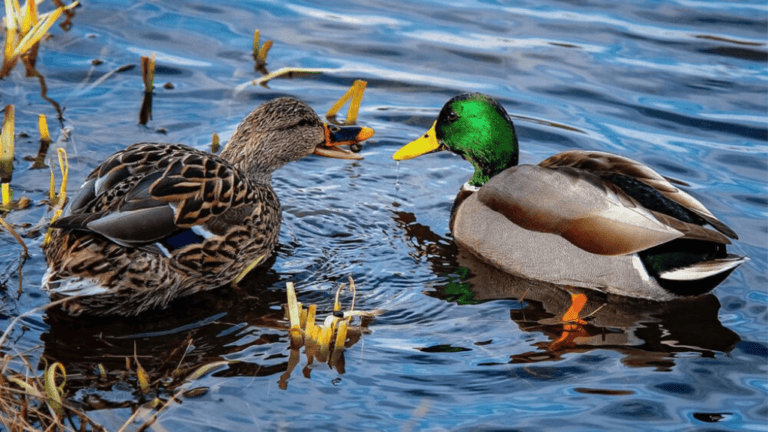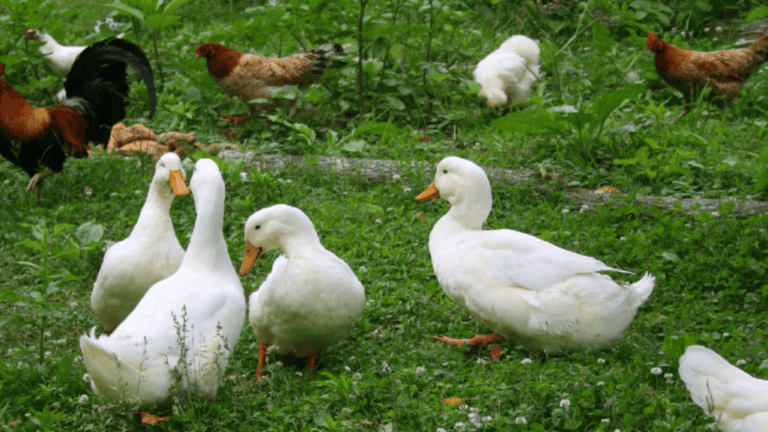Are you ready for a backyard poultry adventure? Look no further than the Pekin duck! These ducks have won the hearts of many. They are a joy to raise and bring many benefits to your home or farm.
Pekin ducks grow fast, produce great meat and eggs, and adapt well to different climates. They are the top choice for meat, ready to be processed at 7-8 weeks. They also lay large, pale green eggs, perfect for baking and cooking.
Whether you’re experienced or new to poultry, Pekin ducks are exciting to raise. They have charming personalities and are very versatile. So, get ready to explore the world of Pekin ducks and enjoy raising these amazing birds!
Key Takeaways
- Pekin ducks are a popular choice for backyard poultry enthusiasts due to their fast growth rate and adaptability.
- These ducks are the most common breed raised for meat, ready for processing at just 7-8 weeks of age.
- Pekin ducks lay large, pale green eggs that are perfect for baking and cooking.
- Raising Pekin ducks offers a sustainable food source and a rewarding experience for homesteaders and small farmers.
- With their charming personalities and versatility, Pekin ducks make a delightful addition to any backyard flock.
Introduction to Pekin Ducks
Start an exciting poultry adventure with Pekin ducks in your backyard! These birds are known for their white feathers and friendly nature. They are a great choice for anyone interested in ducks.
Pekin ducks are hardy and easy to care for. They are less likely to get sick and can live in many climates. Their orange bills and white feathers make them a beautiful sight.
Pekin ducks are great for both eggs and meat. They lay about 200 eggs a year. Their meat is also tasty and healthy.
| Pekin Duck Characteristics | Details |
|---|---|
| Weight | 7-9 lbs (3-4 kg), with males being heavier than females |
| Lifespan | 9-12 years on average, with some living up to 15 years |
| Egg Production | Around 200 eggs per year |
| Growth Rate | Can reach 90% of adult weight by 7 weeks of age with proper feeding |
Pekin ducks love to be around other ducks. They are quiet and easy to handle. They need more space and water than chickens, but their fun nature makes it worth it.
Starting your Pekin duck journey is rewarding. You’ll enjoy watching them play and collecting fresh eggs. Raising Pekin ducks brings joy and satisfaction to your backyard.
History and Origins of Pekin Ducks
Pekin ducks have a rich history and are loved by many. They were first domesticated in ancient China over 4,500 years ago. They were bred for their meat and eggs.
Through careful breeding, the Chinese created many duck breeds, including the Pekin. This duck is known for its calm nature and great meat and egg production.
Domestication in China
The Pekin duck’s story starts in Beijing, China. Farmers there saw the potential of these white ducks. They bred them for size, strength, and growth.
Today, China leads in duck farming, producing over 2.6 million tons of duck meat yearly. The Pekin duck is a key part of China’s food and farming culture.
Introduction to the West
In 1873, Mr. McGrath brought four Pekin ducks from China to Long Island, New York. These ducks were the start of the breed in the U.S. The American Poultry Association recognized them in 1874.
Long Island became a major duck farming area. The breed’s fast growth and good meat quality made it popular. Now, Pekin ducks make up over 95% of duck meat in the U.S.
| Country | Annual Duck Meat Production |
|---|---|
| China | 2.6 million tons |
| France | 200,000 tons |
| United States | 30 million ducks |
Pekin ducks changed the duck farming industry in the West. They introduced new foods like roasted duck and duck eggs. These products are now common in many homes and restaurants.
Characteristics of Pekin Ducks
Pekin ducks are a favorite among backyard poultry lovers. They are known for their unique looks, friendly nature, and great egg and meat production. These birds will surely win your heart and become a valuable part of your home.
Physical Features
Pekin ducks stand out with their pure white feathers from head to tail. Their orange bills and feet add a beautiful contrast. They have a long, elegant neck that looks great as they move around your yard.
Mature Pekin ducks weigh about 8 pounds for hens and 9 pounds for drakes. The jumbo varieties can even reach up to 12 pounds.
Temperament and Personality
Pekin ducks are known for their friendly and social nature. They love being around people and other ducks. They are curious, outgoing, and calm, making them perfect for families and backyard enthusiasts.
They get along well with other birds, creating a peaceful and diverse flock.
Egg and Meat Production
Pekin ducks are famous for their egg and meat production. They lay 200 to 300 extra-large, white eggs a year. Each egg is about 3 ounces, and they start laying eggs at 5 to 6 months old.
For meat, Pekin ducks are a top choice. Ducklings are raised for 6 to 8 weeks to be tender. Standard ducks weigh 4 to 5 pounds, while jumbo ones can be 9 to 11 pounds by 12 weeks old.
| Characteristic | Details |
|---|---|
| Plumage | Pure white |
| Bill and Feet Color | Bright orange |
| Mature Weight (Hens) | 8 pounds |
| Mature Weight (Drakes) | 9 pounds |
| Jumbo Weight | Up to 12 pounds |
| Annual Egg Production | 200 to 300 eggs |
| Egg Weight | 3 ounces |
| Egg Laying Age | 5 to 6 months |
| Meat Production Age | 6 to 8 weeks |
| Meat Production Weight | 4 to 5 pounds |
Benefits of Raising Pekin Ducks
Raising Pekin ducks is great for backyard poultry fans and homesteaders. These birds are fun to keep and offer meat and eggs. They grow fast, reaching 7-8 pounds in 8-12 weeks. Jumbo Pekins can even hit 10-12 pounds at harvest.
Pekin ducks also lay lots of eggs. American Pekins can lay about 150 eggs a year. This is perfect for your family or a small egg business.
Another perk is their pest control in gardens or orchards. They eat slugs, snails, and insects. This keeps your plants healthy and cuts down on chemical use. Adding ducks to your garden makes it more sustainable and eco-friendly.
| Pekin Duck Benefits | Details |
|---|---|
| Fast Growth Rate | Reach butcher weight of 7-8 lbs by 8-12 weeks |
| Excellent Egg Production | American Pekins lay around 150 eggs per year |
| Natural Pest Control | Ducks feast on slugs, snails, and insects in gardens |
| Adaptability | Thrive in various climates and living conditions |
Pekin ducks are hardy and adaptable, perfect for backyard keepers. They need clean water for health but can live in many places. Their pest control and meat and egg production make them a great choice for sustainable homesteads or backyard flocks.
Setting Up Your Backyard Duck Habitat
Creating a cozy and caring space for your Pekin ducks is vital for their happiness and health. You need to give them the right duck housing, a good duck feed, and enough water requirements. This will help your feathered friends flourish in your backyard.
Housing Requirements
Space is key when it comes to duck housing. The Cornell Duck Research Lab suggests up to 3.02 square feet per laying duck. But, a better plan is 20 square feet per duck, especially if they won’t roam free. Your duck house should be tall, with enough floor space and a big enough door for easy entry.
Don’t forget about ventilation to handle the moisture ducks produce. For two ducks, aim for about 44 square feet in a separate area within a bigger run, as The Cape Coop advises.
Feeding and Watering
A balanced diet is crucial for your Pekin ducks’ health and egg laying. Ducklings need high-protein feed for their fast growth. Adult ducks do well on commercial duck feed with fresh veggies and foraging chances. Khaki Campbell ducks, for example, can lay up to 300 eggs a year with the right diet.
Duck eggs are bigger and have more protein than chicken eggs. This makes them a favorite among some, like bodybuilders.
Ducks need constant access to clean water. A simple watering system, like a gravity-fed waterer or a shallow dish, is best. Remember, young ducks need careful watching to avoid drowning.
Providing a Pond or Water Source
Ducks don’t need a pond to live, but they do need a place to swim and dunk their heads. A backyard pond, blow-up kiddie pool, or small dam can be perfect. It lets them swim and keep their feathers clean.
Ducks are very social, so it’s best to keep at least two together. This meets their need for company.
| Duck Housing Requirements | Recommended Space |
|---|---|
| Floor space per laying duck | Up to 3.02 square feet |
| Realistic space allocation per duck | 20 square feet |
| Duck house height | At least 3 feet |
| Floor space per duck in the house | 4 square feet |
| Door dimensions | 14 inches wide, 12-14 inches tall |
By designing a duck habitat that meets their needs, you’ll enjoy raising Pekin ducks in your backyard.
Caring for Pekin Ducklings
Welcoming Pekin ducklings to your backyard is exciting. They need proper care and attention in their early life. With the right setup and diet, they’ll grow into healthy ducks.
Brooding and Temperature Control
Creating a cozy brooding environment is crucial. For the first week, keep the temperature at 95°F (35°C) with a heat lamp. Lower it by 5°F (3°C) each week until they’re fully feathered, around 7-8 weeks.
Make sure they always have clean, fresh water. But, be careful not to drown them. Use a shallow dish with marbles or pebbles to prevent accidents.
Feeding and Nutrition
Good nutrition is essential for healthy ducklings. Use starter feed made for ducklings, as it has more niacin and vitamin E. They need 20-22% protein for growth.
Also, give them fresh fruits and vegetables. Start with finely chopped or grated options to avoid choking. Good choices include:
- Leafy greens like lettuce, kale, and spinach
- Peas, corn, and green beans
- Grated carrots and cucumbers
- Finely chopped berries and melon
Watch their food intake to avoid overeating. Give them space to exercise and explore. This helps keep them healthy and strong.
| Age (Weeks) | Temperature (°F) | Feed Protein (%) | Water Needs (Cups/Day) |
|---|---|---|---|
| 0-1 | 95 | 20-22 | 1/4 |
| 2-3 | 90 | 18-20 | 1/2 |
| 4-5 | 85 | 16-18 | 3/4 |
| 6-7 | 80 | 14-16 | 1 |
| 8+ | Ambient | 14-16 | 1+ |
By giving your Pekin ducklings a warm, safe place and a balanced diet, you’ll raise a thriving flock. They’ll be delightful backyard companions.
Integrating Ducks into Your Backyard Flock
Adding ducks to your backyard chickens can be very rewarding. Pekin ducks are friendly and fit well with chickens. But, it’s important to know how to keep them both happy together.
When you add ducks, keep a balance of 1 drake to 4-6 hens. This stops aggressive behavior and keeps everyone safe. For a big group, like 7 male ducks, add about 25 female ducks. Drakes grow tail feathers after 3-4 months, making it easier to tell them apart.
Baby ducks and chicks need the same warm place to start. But, ducks grow faster and might move to the coop sooner. Be careful with their food, as chick feed isn’t good for ducks. Once they grow up, feeding them together is easier.
Ducks and chickens can share a coop as adults. But, ducks need deeper water for cleaning and mixing food. They also splash a lot, unlike chickens. A small pool for swimming is great for their happiness. For more on their habitat, see Ducks New World.
Ducks stay together and often nest on the coop floor. This might make some hens lay eggs on the ground too. You’ll get a variety of eggs, including brown, green, and white ones.
Chickens and ducks can eat the same layer feed. But, young ducks need extra niacin for growing. They both like treats like mealworms and veggies. For more on their diet, check The Cape Coop.
Ducks like to sleep on the ground, while chickens roost. Make sure there’s a ramp for ducks to get into the coop. They also like to sleep outside in a safe spot.
In a mixed flock, ducks and chickens usually ignore each other. But, a drake or rooster can change things. Keep a balance of 2-3 female ducks per drake to avoid trouble. Drakes can also protect the hens from predators.
By understanding ducks’ needs, you can add them to your flock successfully. Enjoy watching your diverse poultry family grow and thrive. You’ll have plenty of fresh eggs and fun to watch.
Maximizing Egg Production
Pekin ducks are known for their duck egg production. They are great for backyard poultry lovers who want lots of eggs. Knowing how they lay eggs and caring for them well can help you get more eggs from your Pekin ducks.
Laying Habits and Cycles
Pekin ducks start laying eggs at 20 to 23 weeks old. They lay about 200 eggs a year, making them very good at it. To help them lay more, give them 17 hours of light a day. You can use extra lights to make up for the lack of natural light.
They usually lay eggs at night or early morning. They might lay in nests together or alone. Make sure they have good places to lay their eggs. Remember, they might not lay eggs during their three-month molt.
Collecting and Storing Duck Eggs
Collecting eggs every day keeps them fresh and clean. Duck eggs have thicker shells than chicken eggs, so they last longer. But, they still need to be stored right to stay good.
After picking up the eggs, wash them with warm water to get rid of dirt. Then, store them in a cool, humid place. This way, you’ll always have fresh, high-quality duck eggs from your Pekin ducks.
| Breed | Age at First Lay | Eggs per Year | Incubation Period |
|---|---|---|---|
| Golden 300 Hybrid Layer Ducks | 20-23 weeks | 200+ | 28 days |
| White Layer Ducks | 20-23 weeks | 200+ | 28 days |
| Muscovy Ducks | 23-25 weeks | 150-180 | 35 days |
To get even more eggs, consider these tips:
- Give them a balanced diet, no more than 0.35 pounds of feed a day from 3 weeks old until they start laying
- Keep a good balance of males to females, one male for every five or six females
- Make sure they have a regular routine and don’t get stressed
- Give them clean water often, as they eat their food quickly
- Use good lighting, like Sunbird’s, to help them lay eggs better
By following these tips and watching your ducks’ laying habits, you can make your backyard poultry a success. This way, you’ll get lots of eggs and keep your Pekin ducks happy and healthy.
Processing Pekin Ducks for Meat
Starting your backyard poultry journey with Pekin ducks means learning how to humanely slaughter and butcher them. These ducks grow fast and have tender meat, making them a great choice for meat. Bramblewood Hill Farm says you can butcher Pekin ducks at six weeks, weighing about seven pounds. Jumbo males and females can reach 11 and nine pounds, respectively, at 12 weeks.
Humane Slaughtering Methods
There are humane ways to slaughter ducks. The most common is cutting the carotid arteries in the neck, letting them bleed out. This takes about 3 minutes. Others prefer throat slitting or decapitation, which needs a clean break on a hard surface.
Make sure ducks don’t eat for 12-18 hours before slaughter. They should still have access to water.
Plucking and Butchering Techniques
After slaughter, the next step is to prepare the duck for plucking. Soak the bird in 160-170 degrees Fahrenheit water for a minute. Plucking ducks can be tough because of their dense down feathers. Using duck wax can help remove the down.
Butchering ducks requires attention to their anatomy, which is different from chickens. You’ll need a sharp knife, a restraining cone, poultry shears, a hatchet, hot water, bleach, and buckets for organs and waste.
| Duck Breed | Butchering Age | Average Weight (Male) | Average Weight (Female) |
|---|---|---|---|
| Pekin | 7-8 weeks | 7-9 lbs | 7-9 lbs |
| Jumbo Pekin | 12 weeks | 11 lbs | 9 lbs |
| Rouen | 8-10 weeks | 6-8 lbs | 6-8 lbs |
| Muscovy | 12-16 weeks | 10-15 lbs | 6-8 lbs |
By following humane slaughtering and proper plucking and butchering, you can ensure your Pekin ducks are processed well. This way, you’ll have delicious, homegrown meat for your family.
Pekin Ducks as Pest Control
Pekin ducks are not just cute backyard friends. They are also great at controlling pests. These birds love to forage, making them perfect for gardens and orchards. With Pekin ducks around, you can fight off slugs, snails, and insects without using harmful chemicals.
Slugs, Snails, and Insect Control
Pekin ducks eat a lot and go after pests like slugs, snails, and insects. Their keen sense of smell helps them find pests in every corner of your garden. Letting Pekin ducks roam in your garden helps keep pests away and keeps your ecosystem healthy.
Studies show that ducks can cut down on the need for pesticides. This is good for the environment and helps your plants and soil stay healthy. With Pekin ducks watching over your garden, you can grow plants without using harmful chemicals.
Integrating Ducks into Gardens and Orchards
Before bringing Pekin ducks to your garden or orchard, check if your plants are ready. Young plants might get hurt by the ducks’ excitement. It’s safer to wait until your plants are strong before letting the ducks explore.
In orchards, Pekin ducks are super helpful. They eat pests and their poop is great fertilizer. By planning how they graze, you can keep your orchard healthy and productive.
| Duck Breed | Pest Control Effectiveness | Integration Considerations |
|---|---|---|
| Pekin | High | Wait until plants are well-established |
| Runner | High | Suitable for smaller gardens |
| Khaki Campbell | Moderate | May require additional pest control measures |
Choosing the right duck breed and managing them well can make your garden or orchard pest-free. Let Pekin ducks use their natural skills to keep your outdoor space healthy and sustainable.
Common Health Issues and Prevention
Pekin ducks are generally healthy but can face some health problems. Keeping them healthy means watching out for common illnesses and taking steps to prevent them. By knowing the risks and using good prevention, your ducks can stay happy and healthy in your backyard.
Some big health issues for Pekin ducks include viral diseases like duck virus hepatitis and duck virus enteritis. Duck virus hepatitis is very contagious in young ducks and can kill up to 90% of them. Duck virus enteritis, or duck plague, is very deadly and can affect both young and adult ducks. It’s important to keep sick ducks away from others and see a vet right away.
Bacterial infections like Riemerella anatipestifer infection, avian cholera, and colibacillosis are also big threats. Riemerella anatipestifer can cause a lot of deaths and make ducks lose weight. Avian cholera, caused by Pasteurella multocida, is a big problem for ducks in some areas. Colibacillosis affects ducks between 2-8 weeks old, causing problems with hatching and leading to blood infections.
Fungal diseases like aspergillosis and aflatoxin poisoning can also harm Pekin ducks. Aspergillosis happens when ducks breathe in mold spores, causing lung and air sac problems. Aflatoxin poisoning can be very deadly for ducks, especially because they are very sensitive to toxins from Aspergillus flavus and Aspergillus parasiticus.
Other health issues include botulism, castor bean poisoning, and sensitivity to erucic acid in feed. Botulism can cause paralysis in ducks exposed to toxins from Clostridium botulinum. Castor bean poisoning can harm wild ducks that eat castor beans, which contain ricin. Ducks are also more sensitive to erucic acid in some rapeseed meals, so it’s important to watch what they eat.
| Health Issue | Symptoms | Prevention Measures |
|---|---|---|
| Bumblefoot | Swelling, abscesses, or scabs on the foot | Maintain clean living environment, treat cuts promptly |
| Angel Wing | Outward twisting of the wing joint | Provide balanced diet, avoid overfeeding |
| Eye Infections | Swelling, redness, discharge in one or both eyes | Ensure clean water for bathing, isolate infected ducks |
| Impacted Crop | Enlarged, firm crop; lethargy; loss of appetite | Provide adequate grit, avoid feeding indigestible materials |
| Egg Binding & Soft-Shelled Eggs | Difficulty laying eggs, soft or shell-less eggs | Provide balanced diet rich in calcium, supplement with crushed oyster shells |
To keep your Pekin ducks healthy, keep their living area clean, feed them well, and make sure they have clean water. Regular vet visits and quick treatment of any problems can help your ducks stay healthy. By being informed and proactive, you can enjoy having these wonderful birds in your backyard while keeping them safe from health issues.
Conclusion
Raising Pekin ducks is a rewarding experience for those who love backyard poultry and homesteading. These birds give you fresh eggs and meat. They also help control pests in your garden and orchard.
Global duck meat production hit 7.2 million tons in 2018. The USA alone raised nearly 31 million ducks that year. This shows Pekin ducks are becoming more popular everywhere.
To keep Pekin ducks happy, you need to know what they like. They prefer certain nesting materials and need enough space. Studies show that giving them the right space and nesting materials makes them less stressed.
Starting your Pekin duck journey can be exciting. With the right care, they’ll become a big part of your homestead. Enjoying the ups and downs of raising Pekin ducks connects you to nature and small-scale farming.


